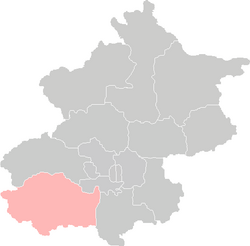Fangshan District
|
Fangshan 房山区 |
|
|---|---|
| District | |

|
|
 Location of Fangshan District in Beijing |
|
| Country | People's Republic of China |
| Municipality | Beijing |
| Township-level divisions | 8 subdistricts 14 towns 6 townships |
| Area | |
| • Total | 2,019 km2 (780 sq mi) |
| Population (2000) | |
| • Total | 814,367 |
| • Density | 400/km2 (1,000/sq mi) |
| Time zone | China Standard (UTC+8) |
| Area code(s) | 010 |
| Website | english |
Fangshan District (simplified Chinese: 房山区; traditional Chinese: 房山區; pinyin: Fángshān Qū) is situated in the southwest of Beijing, 38 km (24 mi) away from downtown Beijing. It has an area of 2,019 square kilometres (780 sq mi) and a population of 814,367 (2000 Census). The district is divided into 8 subdistricts, 14 towns, and 6 townships.
The district administers 8 subdistricts, 14 towns with 3 towns of which carry the "area" (地区) label, and 6 townships:
The Subdistrict area of Fangshan (population 187,667) contains an urban area, has an area of 25 km2 (9.7 sq mi) and an estimated population of 200,000. Other major urban areas are Liangxiang (population estimate 110,000, 93,486 in township), Zhoukoudian (35,000, 39,877 in township), Doudian (30,000, 25,046 in township), and Liulihe (22,000, 37,936 in township).
Fangshan is situated to the east of the Taihang Mountains. The east and south of the district is a fertile plain, with a narrow hilly area running from northeast to southwest. The district has many rivers and lakes; the Juma River, Dashi River, Yongding River, and Xiaoqing River run through the district, assuring abundant water resources.
The location, climate and environment provide good conditions for agriculture. The district produces wheat, rice and various high quality fruits as well as large quantities of animal products. At the moment large investments are made for greenhouse production.
Jingguang railway and Jingyuan railway cross the district. In addition, the district is serviced by 4 branch railways and 24 railway stations. Jingshi Expressway also goes through the district. The four main roads are the Jing-Zhou, Jing-Bao, Jing-Yuan, Jing-Liang roads, with branch roads to townships and villages. The total length of roads is up to 1,800 km (1,100 mi). Tanggu Port is only 180 km (110 mi) distant. The programme-controlled telephone capacity supports 128,000 phone sets.
...
Wikipedia
